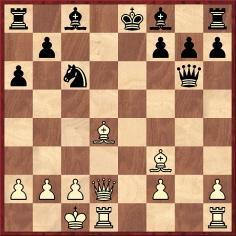
Edward Winter
Maurice Carter (Fairborn, OH, USA) expresses surprise at the extent of the mix-up over Nimzowitsch’s famous victory against Alapin:
1 e4 e6 2 d4 d5 3 Nc3 Nf6 4 exd5 Nxd5 5 Nf3 c5 6 Nxd5 Qxd5 7 Be3 cxd4 8 Nxd4 a6 9 Be2 Qxg2 10 Bf3 Qg6 11 Qd2 e5 12 O-O-O exd4 13 Bxd4 Nc6

14 Bf6 Qxf6 15 Rhe1+ Be7 16 Bxc6+ Kf8 17 Qd8+ Bxd8 18 Re8 mate.
The game’s appearances mentioned by our correspondent are:
As regards contemporary publications, Mr Carter points out the following on page 298 of The Year-Book of Chess 1914 edited by M.W. Stevens (London, 1915):
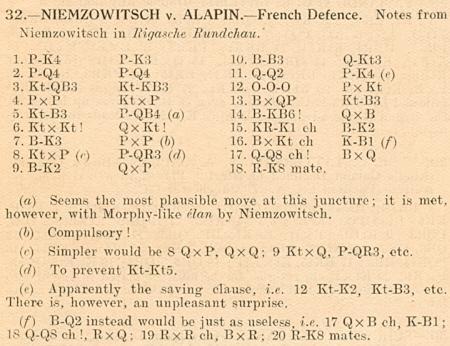
And from page 63 of volume one of Schachjahrbuch 1914 by L. Bachmann (Ansbach, 1914):
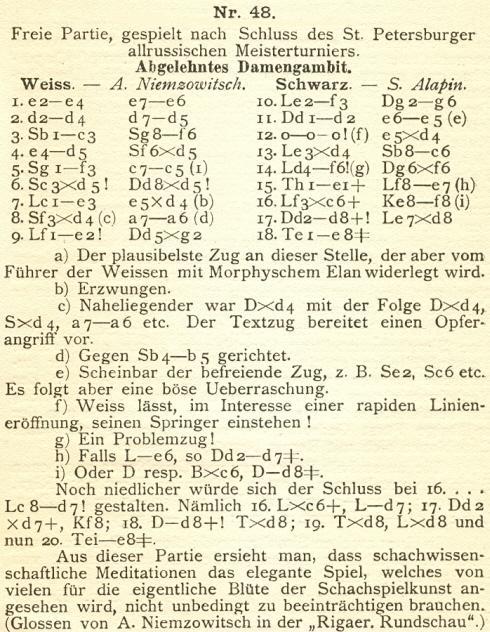
We add some comments. Page 206 of the July 1914 Deutsche Schachzeitung reproduced the same notes to the game, ‘welche nach Beendigung des allrussischen Meisterturniers als freie Partie in St. Petersburg gespielt worden ist’. If a reader has access to the Riga publication, we should like to know whether it too specifically stated that the miniature was an informal game played after the end of the All-Russian Masters’ Tournament in St Petersburg. That event took place from 4 to 31 January 1914 (new style), and it would be curious indeed to find that the Nimzowitsch v Alapin game was thus played in St Petersburg in 1914, an option not mentioned in any of the books listed by Mr Carter.
The original edition of Mein System (Berlin, 1925) gave no venue or date for the game. Nor did the Russian edition (Moscow, 1930). The algebraic version of My System produced by Quality Chess Europe AB (Göteborg, 2007) put Vilnius, 1912. The original English-language translator of My System, Philip Hereford, co-authored with W.H. Watts Every Game Check Mate (London, 1932), and the Nimzowitsch v Alapin game appeared on page 85 (‘Carlsbad, 1911’). On page 164 of 200 Miniature Games of Chess (London, 1941) J. du Mont gave the date as 1915, without specifying any location.
A further question arises from Irving Chernev’s publication of the game in 1000 Best Short Games of Chess and The Chess Companion (pages 262-263 and 242 respectively). Both times he put ‘Riga, 1913’ and stated that Nimzowitsch had called the game ‘The Pride of the Family’. Where did that description originate?
(6784)
‘Vilnius, 1912’ is sometimes rendered as ‘Wilna, 1912’. See, for instance, page 244 of The Best In Chess by I.A. Horowitz and J.S. Battell (New York, 1965).
Javier Asturiano Molina (Murcia, Spain) notes that the ‘Pride of the Family’ phrase appeared when Nimzowitsch presented the game, with a different set of notes, on pages 160-161 of the 1 April 1925 issue of Kagans Neueste Schachnachrichten:
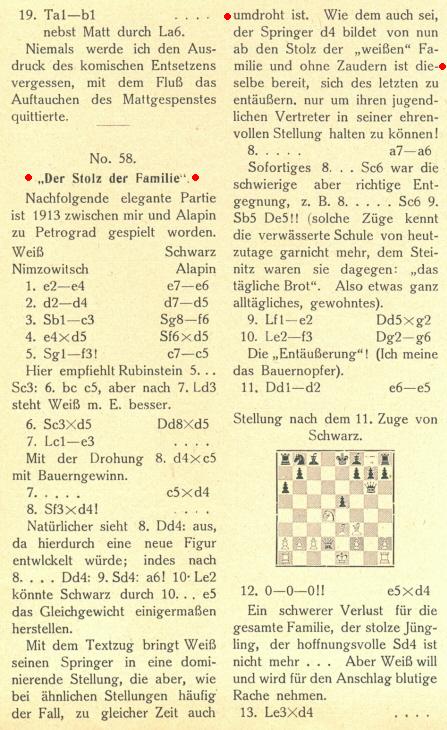
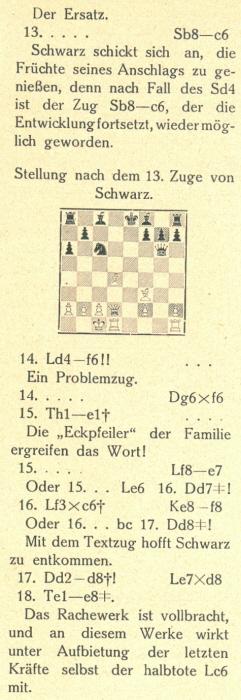
It may be recalled from C.N. 6784 that Irving Chernev mentioned the ‘Pride of the Family’ reference (whilst giving the location of the game as Riga, and not St Petersburg). It now seems to us, though, that on page 242 of The Chess Companion Chernev was incorrect to interpret the ‘Pride of the Family’ remark as a suggestion by Nimzowitsch that it was his favourite game:
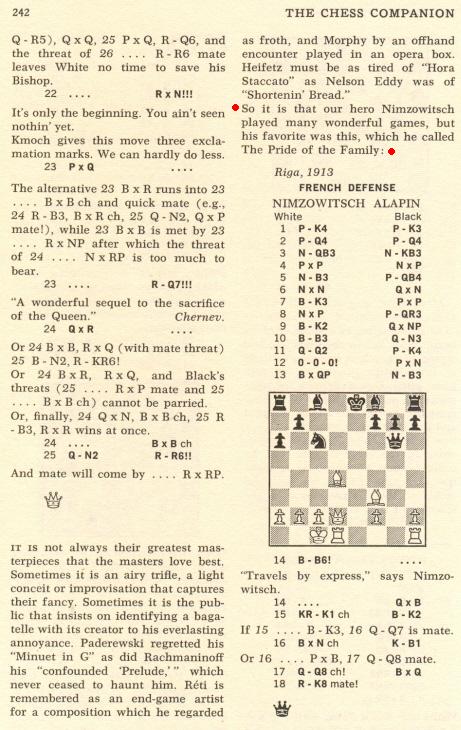
As shown above (Kagans Neueste Schachnachrichten), in his note to White’s eighth move Nimzowitsch described the knight on d4 as the pride of the (white) family. We thus read his heading to the game as a mere reflection of that annotational remark, and not as a description of the game itself.
(6789)
Vitaliy Yurchenko (Uhta, Komi, Russian Federation) mentions that ‘St Petersburg, 1914’ was given as the occasion of the Nimzowitsch v Alapin game in the 1974 and 1984 Russian editions of Nimzowitsch’s My System.
Our correspondent also notes that Tal contributed to those volumes a seven-page Preface on Nimzowitsch. See too the 1999 edition in Czech, Můj systém (pages 7-13).
(6799)
Jens Askgaard (Fakse, Denmark) provides another date for the Nimzowitsch v Alapin game. The Danish translation of My System (1976) had this description: ‘Frit parti, spillet i St. Petersburg maj 1914’ (Casual game, played in St Petersburg, May 1914).
Our correspondent adds that the translator, H.P. Toft, noted in his Foreword that the translation had been undertaken as early as 1941.
(6822)
Jean-Luc Grenier (St-Jerome, Quebec, Canada) and Dan Scoones (Port Coquitlam, BC, Canada) note annotators’ failure to mention that White could have ended the game a move earlier (after 14 Bf6 Qxf6):
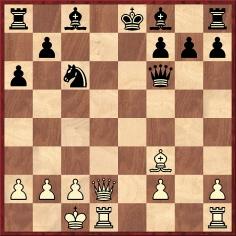
15 Bxc6+ bxc6 16 Rhe1+ and mate next move.
(6835)
Per Skjoldager (Fredericia, Denmark) submits J. Behting’s chess column on page 47 of the Rigasche Rundschau of 4 April 1914 (new style), which has Nimzowitsch’s notes to his win over Alapin:
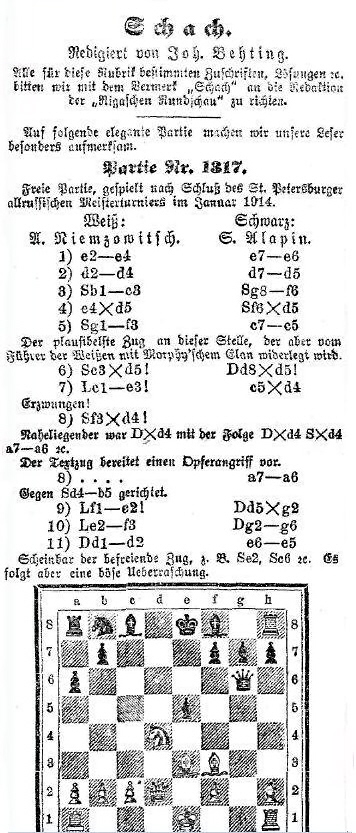
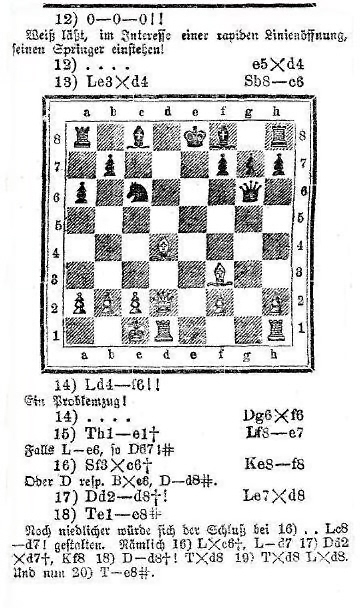

Mr Skjoldager comments:
‘The introduction to the game reads: “Offhand game played after the conclusion of the St Petersburg All-Russian Masters’ Tournament in January [old style] 1914.” If it was indeed played after the tournament ended, that may have been February, and not January. It could have been after the play-off or after the main event. The last round of the tournament was on 30 January 1914, and Nimzowitsch’s two-game play-off match against Alekhine took place on 4 and 5 February (with two adjournments). These dates are in the new style.
Thus Nimzowitsch would say “January” because of the Julian calendar in use in Russia. However, I think that the game was more probably played at the beginning of February (Gregorian calendar) or, possibly, on 31 January, although Nimzowitsch played a long game on 30 January. All in all, “January” is uncertain.’
(7568)
Nimzowitsch’s notes were reproduced on pages 101-102 of Schachmeisterpartien des Jahres 1914 (volume two) by Bernhard Kagan (Berlin, 1915). No information about the occasion of the game was given in the heading.
Page 159 of Chess for Children by R. Bott and S. Morrison (London and Glasgow, 1958) stated that the game ‘was played in the Carlsbad Tournament, 1911’.
Randall K. Julian (Zionsville, IN, USA) observes that there are databases which give the opening as a Sicilian Defence, and not a French Defence: 1 e4 c5 2 Nf3 Nf6 3 Nc3 d5 4 exd5 Nxd5 5 d4 e6 6 Nxd5 Qxd5 7 Be3 cxd4 8 Nxd4 a6 9 Be2 Qxg2 10 Bf3 Qg6 11 Qd2 e5 12 O-O-O exd4 13 Bxd4 Nc6 14 Bf6 Qxf6 15 Rhe1+ Be7 16 Bxc6+ Kf8 17 Qd8+ Bxd8 18 Re8 mate.
What are the origins of this version of the game-score?
(8451)
Per Skjoldager has forwarded pages 132-133 of Der Schachwart, July 1931:
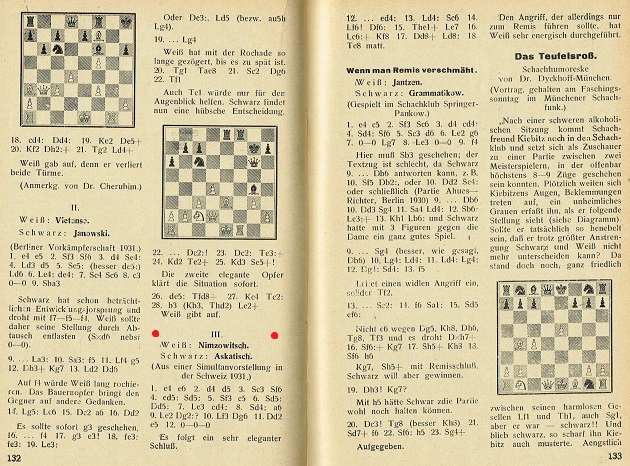
Our correspondent notes that this game, supposedly played by Nimzowitsch in 1931 against Askatisch in a simultaneous exhibition in Switzerland, is identical to his famous offhand win against Alapin. Can further particulars be found?
Below is a table of Nimzowitsch’s results in simultaneous displays during his Swiss tour, as reported on page 36 of the March 1931 issue of the Schweizerische Schachzeitung.
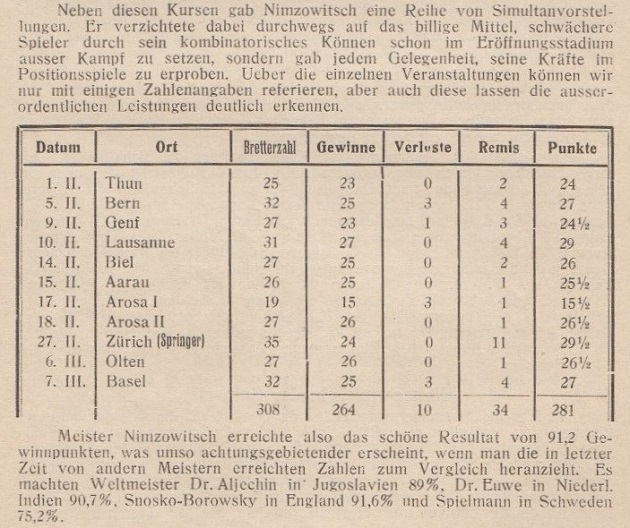
(9365)
See too Articles about Aron Nimzowitsch.
To the Chess Notes main page.
To the Archives for other feature articles.
Copyright: Edward Winter. All rights reserved.